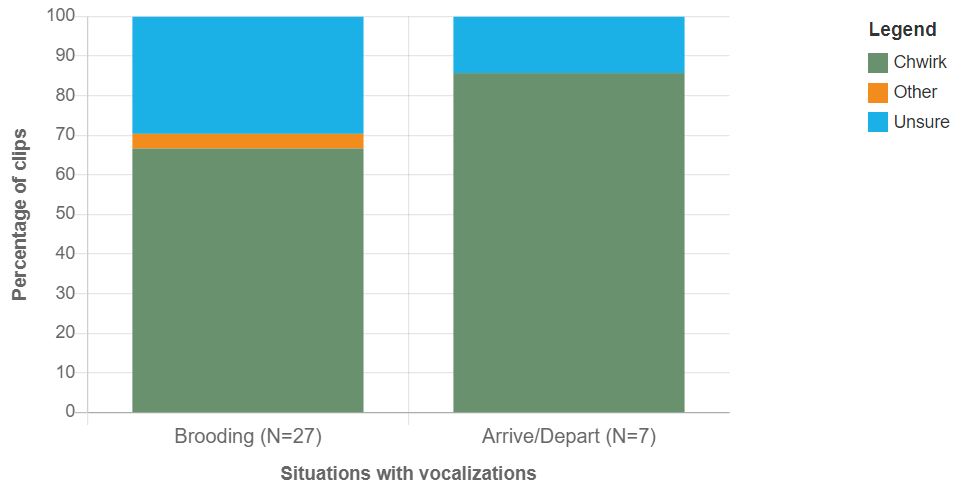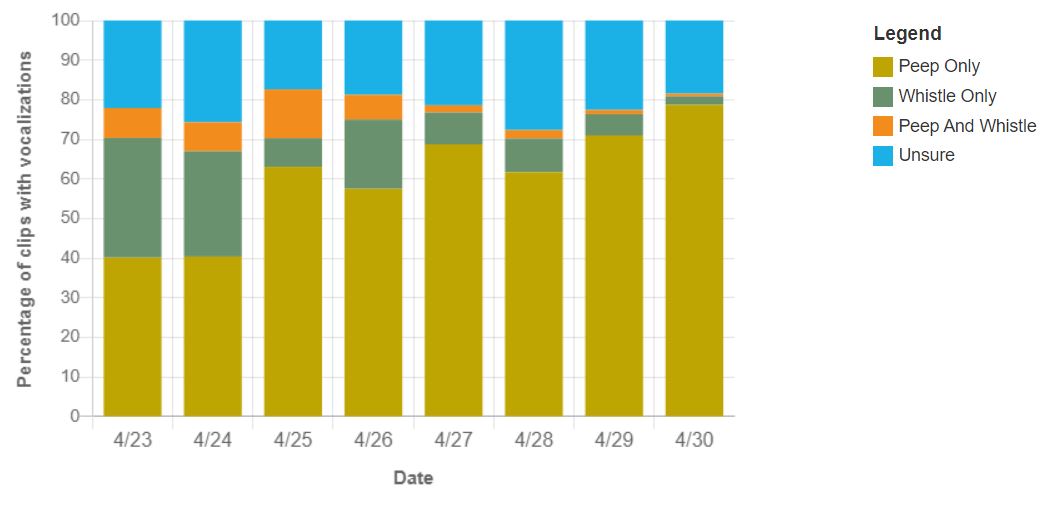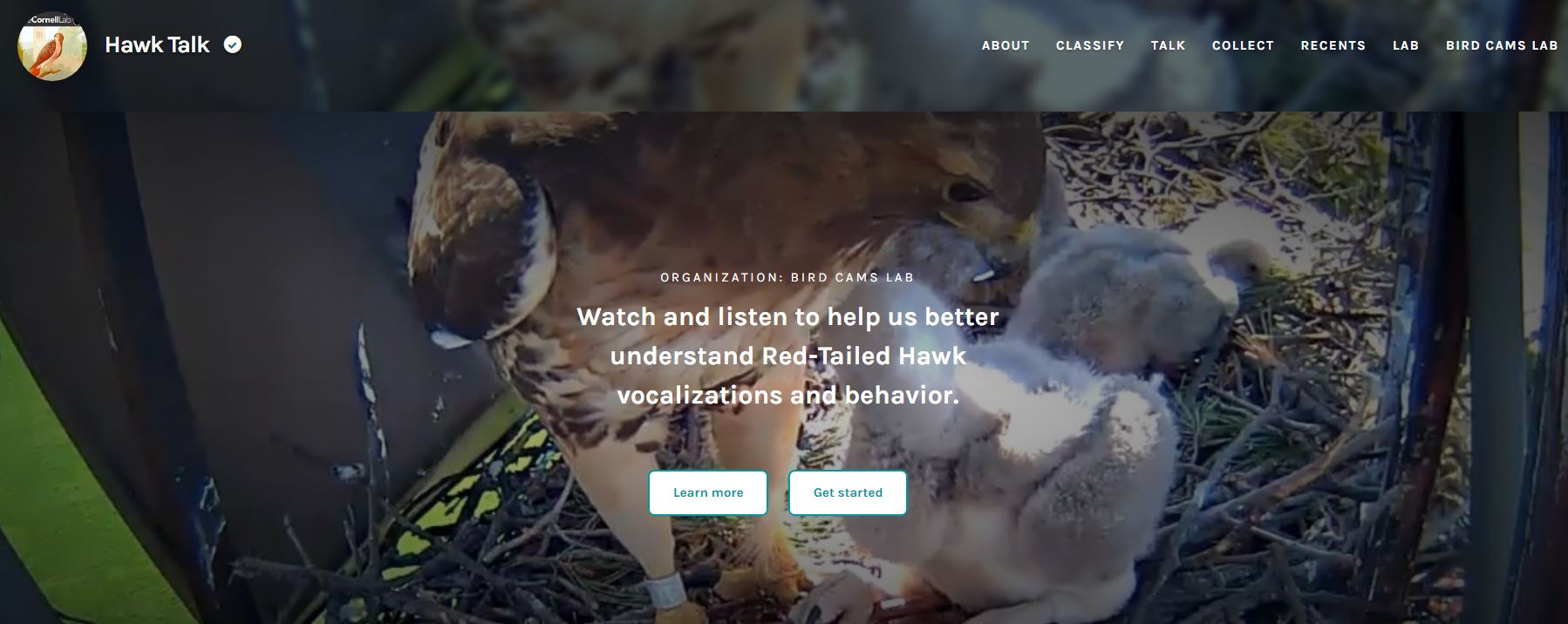Final Hawk Talk Report
March 19, 2020—Posted by Rachael Mady on behalf of Bird Cams Lab
Background
Over the past decade, the communities watching the Cornell Lab of Ornithology’s live Bird Cams have surfaced new insights about the birds featured on cam. One such community watching the Red-tailed Hawk cam took the next step and began logging each prey item brought to the nest using Twitter and Google spreadsheets. To date, they have created the most comprehensive record of prey brought to a Red-tailed hawk nest.
This community effort inspired us to create the Bird Cams Lab, an online space that aims to connect cam viewers with scientists to co-create scientific investigations centered on the cams. Participants are able to join in one or all parts of the scientific process: observing birds on cam, posing questions, collecting data, analyzing and interpreting results, and sharing findings.
We launched a pilot project in 2018 and invited Red-tailed Hawk viewers to post their observations and questions in a forum titled the “Wonder Board.” There, viewers discussed with each other and researchers about what they were seeing and what they wanted to potentially investigate. The community was interested in knowing more about a wide range of topics, from vocalizations to nestling aggression to feeding patterns at the nest.
An important part of the discussion was determining which questions were possible to answer using the footage from the cam, and whether they had already been answered by previous researchers. We worked with the community to figure out which questions were “cam-testable,” such that the questions were specific, measurable, and feasible within the time frame we had available. On forums and in a live question and answer session, seven questions surfaced and we spent time revising, refining, and reviewing what was known in the literature.
The community took a final vote.
A question about vocalizations rose to the top: “Do hawks use different kinds of calls in different situations at the nest?” Researchers had previously documented a variety of Red-tailed Hawk vocalizations, but a detailed study of the association between vocalizations and behaviors at the nest had not been done.
Methods
With the question in hand, researchers at the Cornell Lab set up a project called “Hawk Talk,” using the Zooniverse citizen-science platform so that participants could collect data from archived video footage of the Red-tailed Hawk nest.
We segmented the footage into 10-second clips that were served up in random order to each participant. From each clip, we collected data on (1) hawk presence, (2) behavioral situations, and (3) vocalizations. There were seven situations that participants could mark as happening at the nest (e.g., adults arriving or departing from the nest, feeding or brooding the young), along with a “None of the above” option.
Participants played an important role in the design of the data collection protocol, giving feedback for each version of the protocol we tested. For example, based on the literature, we set out to document nestling “peeps” and “other” vocalizations, but participants noticed “whistles” and requested we include that as a separate category.
Open Cam In New Window
A total of 1,440 participants collected data from the project’s launch in January 2019 to its completion in August 2019. The final data set consisted of 8,044 10-second clips from one week after the nestlings hatched in 2018. Each clip was watched by at least 6 people, resulting in a total of 48,313 video classifications.
We extracted the data from Zooniverse with the help of a volunteer collaborator, Peter Mason, and distilled the multiple observations for each clip down to one observation by calculating vote fractions and using a consensus threshold of 60%. Vote fractions are the fraction of participants that classified a certain observation in a category. For example, if 5/6 people heard the nestlings “peep” but one person didn’t, then the vote fraction for “peep” is 5/6, or 83%, and for “no peep” is 1/6, or 17%. The 83% is above the consensus threshold and for that clip we would record that there were nestlings peeping.
In addition to calculating vote fractions for vocalization types and behaviors, we calculated a vote fraction for vocalization presence. As we worked with the data, we realized that sometimes it was easier for participants to identify that there was a vocalization, but not necessarily the type of vocalization. For example, if 3 out of 6 people (50%) classified that a clip had a nestling “whistle” and the other 3 people classified a nestling “peep,” we wouldn’t have agreement on the type of vocalization but we would have 100% agreement that there was some sort of nestling vocalization.
Preliminary Descriptive Results
We used the data to generate interactive visualizations (which can be accessed here) so that the community could explore the data with the researchers. Eight people participated in the forums, highlighting what they found most interesting and asking questions to clarify what the graphs were showing. We also hosted a live question and answer session to walk through the visualizations and answer any questions from Hawk Talk participants as well as viewers of the Red-tailed Hawk cam..
We found that in the first week after the nestlings began to hatch, the nestlings vocalized in many more clips (N = 1,109) than adults (N = 45). When nestlings were vocalizing, the most common situation at the nest was brooding or feeding, whereas when adults were vocalizing, brooding was even more common, followed by arrivals or departures of adults (Figure 1).
Relationship between situations and vocalizations
 Figure 1. For clips with nestlings vocalizing and adults vocalizing, the percentage of clips is shown for each of four situations. There is a “none of the above,” category when the situation did not fit into any available category and “unsure,” when there was no final agreement among participants as to what was happening (i.e. did not meet the 60% consensus threshold). “N=” shows the number of clips classified as having vocalizations by nestlings or adults..
Figure 1. For clips with nestlings vocalizing and adults vocalizing, the percentage of clips is shown for each of four situations. There is a “none of the above,” category when the situation did not fit into any available category and “unsure,” when there was no final agreement among participants as to what was happening (i.e. did not meet the 60% consensus threshold). “N=” shows the number of clips classified as having vocalizations by nestlings or adults.. When we looked at the different types of nestling vocalizations, we found that “peeps” were the dominant vocalization (Figure 2). When there were arrivals/departures, there were more whistles, but the fact that there were only 9 clips where there were arrivals and departures with vocalizations makes it difficult to make comparisons with other situations (Figure 2.). For adults, “chwirk” was the dominant vocalization type and the most common in brooding and arrivals/departures (Figure 3). Unfortunately, the number of clips with vocalizations for adults is so small that it is difficult to draw conclusions. And we have to keep in mind that some situations at the nest, like brooding, are so much more frequent that vocalizations may happen during brooding simply because it is frequent, not because there is an association.
“Peep” is the most common type of nestling vocalization across situations at the nest
 Figure 2. Out of the clips with each situation that coincided with a nestling vocalization, the percentage of clips for each type of vocalization is shown. “Unsure” refers to vocalizations that participants could not agree upon (i.e. did not meet the 60% consensus threshold).“N=” shows the number of clips that had that situation as well as some nestling vocalization.
Figure 2. Out of the clips with each situation that coincided with a nestling vocalization, the percentage of clips for each type of vocalization is shown. “Unsure” refers to vocalizations that participants could not agree upon (i.e. did not meet the 60% consensus threshold).“N=” shows the number of clips that had that situation as well as some nestling vocalization.
“Chwirk” is the most common type of adult vocalization across situations at the nest
 Figure 3. Out of the clips with each situation with an adult vocalization, the percentage of clips for each type of vocalization is shown. “Unsure” refers to vocalizations that participants could not agree upon (i.e. did not meet the 60% consensus threshold). “Other” refers to vocalizations that participants agreed did not fit into any of the available categories to describe vocalizations. “N=” shows the number of clips that had that situation as well as some adult vocalization. Only two situations with vocalizations are shown on the horizontal axis because the others had a sample size of N=1.
Figure 3. Out of the clips with each situation with an adult vocalization, the percentage of clips for each type of vocalization is shown. “Unsure” refers to vocalizations that participants could not agree upon (i.e. did not meet the 60% consensus threshold). “Other” refers to vocalizations that participants agreed did not fit into any of the available categories to describe vocalizations. “N=” shows the number of clips that had that situation as well as some adult vocalization. Only two situations with vocalizations are shown on the horizontal axis because the others had a sample size of N=1.
Interestingly, we found that the type of vocalizations nestlings are making might change as they get older. Across time, the percentage of clips with nestling vocalizations with whistles decreased and peeps increased (Figure 4). However, as participants pointed out in our discussion in the online forums and in the live question and answer session, this pattern could be driven by the fact that not all nestlings had completely hatched until 4/26, as pointed out by miksohca.
Nestling vocalizations may change as they get older
 Figure 4.Out of the clips with vocalizations for each date, the percentage of clips with each type of vocalization is shown. “Unsure” refers to the clips in which participants did not agree on what the vocalization type was (i.e. did not meet the 60% consensus threshold). Note that the nestlings were not all hatched until 4/26.
Figure 4.Out of the clips with vocalizations for each date, the percentage of clips with each type of vocalization is shown. “Unsure” refers to the clips in which participants did not agree on what the vocalization type was (i.e. did not meet the 60% consensus threshold). Note that the nestlings were not all hatched until 4/26.
In summary, our investigation did not reveal associations between certain situations at the nest with certain types of vocalizations. However, the data suggest that there may be an association between vocalizations in general and certain situations. The results also show that there might be a change in the nestling vocalizations from fewer “whistles” to more “peeps” as nestlings get older, but more data would need to be collected across a longer time frame to confirm this.
At this point, we have successfully conducted an online investigation co-created by viewers and scientists, and summarized our findings. The next step toward publishing the results in a peer-reviewed scientific journal would be to conduct more research across a longer time period in additional nests, and use statistical analyses to gauge the likelihood that patterns are meaningful rather than being generated by chance. For now, we have learned something new about the Red-tailed Hawks on the cam and can use this information to inform the next investigation.
Interested in taking part in the next investigation?
Sign up for Bird Cams Lab to learn how to get started.
Acknowledgements
Thank you to everyone who participated in any aspect of the Hawk Talk project. From brainstorming questions to data collection to data exploration, participants made this project possible. For this pilot project, 220 participants signed up to participate in Hawk Talk and receive correspondence, and 1,440 volunteers collected data on Zooniverse.
Thank you as well to the Zooniverse team for helping design the project and communicate with all of the participants. A special thank you to Peter Mason, a Zooniverse volunteer and programmer who joined the Bird Cams Lab team and helped extract and filter all of the data from Zooniverse.
This project was funded by the National Science Foundation grant 1713225. Any opinions, findings, and conclusions or recommendations expressed in this material are those of the author(s) and do not necessarily reflect the views of the National Science Foundation.

